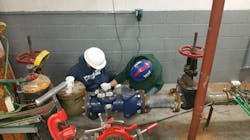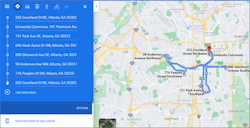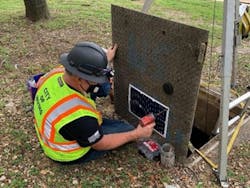Through the years, utilities have been presented with complex challenges related to managing the cycle of providing clean, safe drinking water. These challenges arise in all stages: from raw water intake to drinking water treatment, water distribution, wastewater transport, and wastewater treatment. Utilities are challenged with identifying solutions for aging infrastructure, lack of funding for capital improvements and increasing operating costs.
Identifying viable solutions to address these issues requires utilities to embrace technology. Specifically, technology that remedies the current challenges and allows for proactive management to mitigate future issues. With this foresight, many utilities are moving in the direction of innovation and smart water capabilities to combat workforce, budgetary, and operational limitations.
Today, cities are discovering that even small investments in a smart water solution can result in additional revenue, better asset management and operational efficiency.
Recovering Revenue and Using It to Fund Other Initiatives
The impacts of the COVID-19 pandemic leave municipal governments with the possibility of revenue shortfalls for years to come. Various revenue sources are likely to be affected for months, if not years, but one revenue stream — water utilities — can help offset these potential shortfalls.
The primary source of revenue for most utilities is through the delivery of water and wastewater services. But a small subset of meters — those serving commercial and industrial customers — can represent up to 60 percent of a utility’s annual revenue.
These meters are the cash registers for city water departments. The average monthly revenue from one of these high-value meters can bring in thousands each month. However, studies show that as many as 40 percent of all high-volume commercial water meters can be under billing and need repair. Even under normal conditions, meters can lose accuracy by more than 10 percent per year. If just a few of these high-value meters fail, a water utility can feel the economic effects.
The City of Atlanta has been a leader in the smart water movement for years. In 2018, the city launched a limited-scale trial program using new technology to put sensors on 20 meters. Working with Olea Edge Analytics, those sensors identified malfunctioning meters and helped utility executives prioritize repairs. In three months, the City of Atlanta validated over a million dollars in recoverable revenue for the water department.
Emboldened by those initial results, the program grew to 700 meters. Atlanta initially allocated $1 million to the project. In less than 12 months, the program identified $10 million in potential revenues; a $300 fix to one Atlanta meter was worth $53,000 a month to the city. That additional revenue will be used to fund more projects for Atlanta’s Department of Watershed Management.
With millions of gallons of water per day surging through these meters, cities can begin to address their budget shortfalls by identifying and making repairs. That type of return results in tangible and real-time dollars to address the city’s infrastructure needs.
Better Asset Management Through Technology
Most water utilities expend a great deal of energy and capital on critical assets. Asset management plans are developed for the assets needed to convey and treat source water, distribute clean drinking water, and remove and treat the byproducts. These plans are developed to guide the utility through the preventative maintenance, repair, and replacement process.
Most asset management plans are quite comprehensive, but new technology can certainly change the approach. This was the case in Irving, Texas, where new technology changed how large commercial meters are managed. Typically, water utilities utilize an industry-standard approach of meter flow testing. Flow testing to determine if large meters are functioning appropriately can occur annually or at even longer frequencies for each meter. However, the City of Irving utilized innovative technology to examine a new approach to managing their large meter assets.
The City of Irving identified 50 of its high-value meters and applied an advanced asset management tool from Olea to continuously monitor and diagnose needed corrective actions to maintain the meter accuracy. These meters are large and difficult to maintain or replace; therefore, developing an improved plan to address failures, point repairs, and preventative maintenance was a key motivator for implementing a trial of the advanced asset management tool.
The new innovative solution includes an edge computer and a series of sensors (optical, vibration and magnetic) on each high-value meter to measure meter accuracy and provides the utility with actionable intelligence (specific meter issues and repair recommendation). The meter analytic reports are accessible to the city’s Water Utilities Department via a web-based dashboard, which serves as a repository for each meter’s survey data and meter health analytics reports. Of the 50 meters analyzed, 21 were identified as underperforming compared to manufacturer specifications and AWWA standards, resulting in lost revenue. Repairing failed meter components identified through analysis results in revenue recovery.
Olea’s technology and Meter Health Analytics augment asset management strategies and harness revenue recovery. Integrating continuous monitoring as part of the asset management plan will help ensure assets are maintained at optimum performance for accuracy in metering and utility billing. A utility armed with data and meter health analytics can prioritize repairs and replacements.
Operational Efficiency
Gwinnett County, Ga., is home to The Water Tower, a water innovation center designed to test and demonstrate new technologies.
A 2020 pilot on 25 commercial meters identified 56 percent of meters with common performance error conditions ranging from basic register repairs to more complex meter component deficiencies. Olea’s solution analyzes meter performance while calculating consumption through the meter and related infrastructure over an extended period under normal operating conditions defined by calculated demands that determine meter specifications. The technology and methodology result in a higher rate of accuracy when compared to AWWA M-6 accuracy flow testing that flows through a test port and out of the meter.
The county now can review the data and the analysis from Olea’s platform, which can aid in updating business practices impacting operational efficiency. The data and analysis provide a specific diagnosis, so resources typically utilized to diagnose issues can now focus on fixing the problem. In addition, the information provided from the platform can help the county achieve a one-time repair visit because the specific repair was identified. The right personnel with the right parts and tools can be deployed only once to handle a complete repair, even with multiple problems to fix at one location.
A platform that allows full visibility of assets influences operational changes that result in increased efficiencies, lower operating costs and revenue recovery.
Water Management with a Higher Purpose
Water utilities are always keenly focused on providing clean, safe drinking water while keeping employees safe. These efforts are certainly heightened during the COVID-19 pandemic. Utilities are making valiant efforts to maintain continuity of essential functions and keep some non-essential but extremely important and impactful functions at the forefront.
Utility leadership must contemplate not only the current circumstance, but also strategies to address the efficiency of process and people, revenue shortfalls and technological preparedness. As leaders in the water industry seek mechanisms to advance the approach to water management, selecting the right technology is an important step. Finding innovative solutions that can address more than one challenge can have long-term cascading benefits for water utilities. WW
About the Author: Dave Mackie is founder of CEO of Olea Edge Analytics, an intelligent edge computing platform for the water utility industry.
About the Author
Dave Mackie
Dave Mackie is founder of CEO of Olea Edge Analytics, an intelligent edge computing platform for the water utility industry. Olea's proven technology empowers utilities to optimize water delivery, billing and conservation so cities can generate millions more in revenue. Committed to helping water utilities combat aging infrastructure, meet greater demand and limit rate increases, Olea's patented solution combines IoT and edge computing capabilities to bring transparency, accuracy and reliability to the delivery of the world’s most precious resource.



